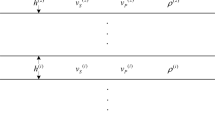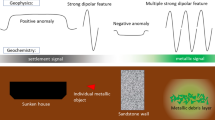Abstract
3D inversion of borehole-surface electrical data for complex geo-electrical models is still a challenging problem in geophysical exploration. We have developed a program for 3D inversion to borehole-surface electrical data based on the quasi-analytical approximation (QA) and re-weighted regularized conjugate gradient method (RRCG) algorithms using Visual Fortran 6.5. Application of the QA approximation to forward modeling and Frechet derivative computations speeds up the calculation dramatically. The trial calculation for synthetic data of theoretical model showed that the program is fast and highly precise.
Similar content being viewed by others
References
Anderson, W. L., 1984, Computation of Green’s tensor integrals for three-dimensional electromagnetic problems using fast Hankel transforms: Geophysics, 49, 1754–1759.
Dmitriev, V. I., and Nesmeyanova, N. I., 1992, Integral equation method in three-dimensional problems of low-frequency electrodynamics: Computational Mathematics and Modeling, 3(3), 313–317.
Habashy, T. M., Groom, R. W., and Spies, B. R., 1993, Beyond the Born and Rytov approximations: a nonlinear approach to electromagnetic scattering: Journal of Geophysical Research, 98(B2), 1759–1775.
He Zhanxiang, Liu Xuejun, Qiu Weiting, and Huang Zhou, 2004, High-power surface-borehole electrical method in predicting reservoir boundary and its application: Petroleum exploration and Development (in Chinese), 2004, 31,74–76.
He Zhanxiang, Liu Xuejun, Qiu Weiting, and Huang Zhou, 2005, Mapping reservoir boundary by boreholesurface TFEM: The Leading Edge, 24, 896–900.
Hohmann, G. W., 1975, Three-dimensional induced polarization and EM modeling: Geophysics, 40, 309–324.
Hohmann, G. W., 1988, Numerical modeling for electromagnetic methods of geophysics, in Nabighian, M. N., Ed., Electromagnetic methods in applied geophysics: Soc. Expl. Geophys., 313–363.
Hursán, G. and Zhdanov, M. S., 2002, Contraction integral equation method in three-dimensional electromagnetic modeling: Radio Science, 37, 1089–1102.
Newman, G. A., and Hohmann, G. W., 1988. Transient electromagnetic responses of high-contrast prisms in a layered earth: Geophysics, 53, 691–706.
Oristaglio, M. L., 1989, An inverse scattering formula that uses all the data: Inverse Problems, 5, 1097–1105.
Portniaguine, O. N., and Zhdanov, M. S., 1999, Focusing geophysical inversion images: Geophysics, 64, 874–887.
SanFilipo, W. A., and Hohmann, G. W., 1985, Integral equation solution for the transient electromagnetic response of a three-dimensional body in a conductive half-space: Geophysics, 50, 798–809.
Singer, B. S., and Fainberg, E. B., 1997, Fast and stable method for 3-D modeling of electromagnetic field: Exploration Geophysics, 28, 130–135.
Tikhonov, A. N., and Arsenin, V. Y., 1977, Solution of illposed problems: John Wiley and Sons, New York.
Wannamaker, P. E., Hohmann, G. W., and SanFilipo, W. A., 1984, Electromagnetic modeling of three-dimensional bodies in layered earths using integral equations: Geophysics, 49, 60–74.
Wannamaker, P. E., 1991, Advances in three-dimensional magnetotelluric modeling using integral equations: Geophysics, 56, 1716–1728.
Xiong, Z., 1992, Electromagnetic modeling of threedimensional structures by the method of system iterations using integral equations: Geophysics, 57, 1556–1561.
Xiong, Z., and Kirsch, A., 1992, Three-dimensional earth conductivity inversion: Journal of Comp. and Appl. Math., 42, 109–121.
Zhdanov, M. S., and Fang, S., 1996, Quasi-linear approximation in 3-D electromagnetic modeling: Radio Science, 31, 741–754.
Zhdanov, M. S., Fang, S., and Hursan, G., 2000a, Electromagnetic inversion using quasi-linear approximation: Geophysics, 65, 1501–1513.
Zhdanov, M. S., Dmitriev, V. I., Fang, S., and Hursan, G., 2000b, Quasi-analytical approximations and series in electromagnetic modeling: Geophysics, 65, 1746–1757.
Zhdanov, M. S., and Hursan, G., 2000, 3-D electromagnetic inversion based on quasi-analytical approximation: Inverse Problems, 16, 1297–1322.
Zhdanov, M. S., 2002, Geophysical inverse theory and regularization problems: Elsevier.
Author information
Authors and Affiliations
Additional information
Wang Zhigang is a PhD student at China University of Geosciences (Beijing). He received a master’s degree in Earth Survey and Information Technology from the China of Geosciences (Beijing) in 2004. His research work mainly focuses on the borehole-surface electrical method and MT.
Rights and permissions
About this article
Cite this article
Zhigang, W., Zhanxiang, H. & Haiying, L. Three-dimensional inversion of borehole-surface electrical data based on quasi-analytical approximation. Appl. Geophys. 3, 141–147 (2006). https://doi.org/10.1007/s11770-006-0021-4
Received:
Revised:
Issue Date:
DOI: https://doi.org/10.1007/s11770-006-0021-4




